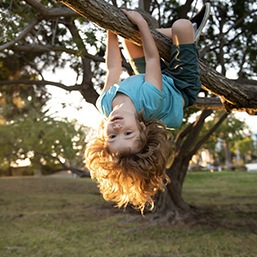
Many of us can think back on a childhood filled with memories of playing outside with our friends, building forts, riding our bikes, exploring, and taking risks. Most children today do not have those same experiences, as outdoor risky play has been rapidly disappearing from childhood over the past few generations. According to ParticipACTION (2020), only 21 percent of Canadian children play more than an hour and a half outside each day.
Free, unstructured play is a fundamental part of childhood, and a critical piece in the healthy development of children. Outdoor play in particular offers mental, physical, and social benefits that cannot be replicated in an indoor space. When children are free to explore and play the way they wish, risky play will almost always emerge. There has been a misunderstanding of what risky play is in the past few years, and because of this we have restricted children’s opportunities to seek out risks. Unfortunately, this has had a detrimental impact on children’s physical, mental, and social wellbeing.
Risky play offers children opportunities to build social and executive functioning skills, resiliency, problem-solving skills, and risk management skills. It teaches children to have confidence in their abilities, how to recognize risk, as well as how to develop ways to engage with and overcome risk. Risky play offers a sense of thrill and excitement, and even though there is a chance of injury, like climbing a tree, the child can recognize the risk and choose to interact with it or not. Risky play is not hazardous play, nor does it mean unsupervised play. A hazard is something that can’t be seen and will cause harm, like a rotten branch that could snap while a child is climbing. Allowing our children to engage in risky play doesn’t mean putting them in harm’s way, but rather viewing them as capable and competent decision-makers, encouraging and teaching them to make good decisions based on their own abilities.
As adults, we need to shift our mindset about risky play, understand that it is nuanced, and notice how it looks different based on the individual child, their abilities, age, and the environment. There are many ways for a child to engage in risky play, but here are six main types of risky play:
Risky play for a two-year-old may involve climbing up and jumping from smaller rocks or boulders, while risky play for an eight-year-old may test their limits by climbing a tree. The necessary life skills and developmental benefits of risky play far outweigh the possibility of injury.
So what can we do? Get our kids back outside and give them the space and freedom to play! When children are outside, they have the freedom to run, jump, climb, and roll on many different types of surfaces, and at different heights and speeds. The landscape and varied terrain offers many different opportunities for play, and is rich with risky play possibilities - from climbing trees and building forts, to traversing difficult terrain and exploring new places.
Our role as parents and teachers is to let children engage with those risky play opportunities, and focus on the learning that is happening, not our own fears. We often stop a child’s play not based on their abilities or comfort level, but based on our own. Taking away opportunities to engage in risky play doesn’t keep our children any safer and can rob them of the opportunity to discover their own limits.
Next time you are watching your children play, try counting to 30 before jumping in to help the child navigate that task - give them an opportunity to figure things out on their own. Instead of saying, “Be careful,” try asking open-ended questions like, “How do you plan on coming down from up there?” or, “What part of the branch do you think is strongest for climbing on?” If our hope is to raise confident, competent, and resilient children, giving them the chance to engage in outdoor risky play is such an incredible (not to mention fun!) way to achieve that goal.
Sarah has a Bachelor of Physical Education from the University of Alberta and was the supervisor of the City of Calgary’s Mobile Adventure Playground. As the owner of Playful Adventures (IG: @playfuladventures), she is passionate about teaching people how to bring more outdoor play into their programs. Reach her at hello@playfuladventures.ca.
See our related articles:
Calgary’s Child Magazine © 2025 Calgary’s Child